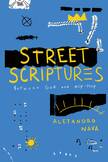Review: Hip-hop’s divine blend of poetry, song and story
With Street Scriptures: Between God and Hip-Hop, Alejandro Nava introduces an intervention into the excesses and shortcomings of two of the major theological movements of the 20th century: Latin American liberation theology and Hans Urs von Balthasar’s theology of beauty, the via pulchritudinis. He notes how liberation theology underdetermined beauty as a suspicious distraction from social justice, while the theology of beauty, in liturgy and beyond, overdetermined beauty through a fixed cultural lens. From the outset, Nava exposes a Catholic political and aesthetic anthropology as bankrupt without an equally robust cultural anthropology.
This erudition and range make the book’s most compelling case for itself. If anything, Nava’s method of dynamically deploying the canon deserves its own book, set apart from theology and perhaps revealing far more about the craft of hip-hop.
This short book is thoroughly annotated with references and footnotes ranging from classical antiquity to contemporary hip-hop. In Footnote 47 of Chapter Four (my favorite chapter), for instance, on the music of rapper Kendrick Lamar, Nava contrasts Lamar’s song “Loyal,” featuring the international pop sensation Rihanna, with R&B singer Chris Brown’s earlier eponymous diss track of Rihanna as a thematic setting continuous with Hesiod’s Theogony.
Nava’s introduction is haunted by the distinction between high and low culture. I share Nava’s hostility toward this division, one born of German cultural theory.
Nava’s introduction is haunted by the distinction between high and low culture. I share Nava’s hostility toward this division, one born of German cultural theory. I am not as confident, however, that its destruction will be accomplished through external additions or subtractions. We should begin from the ground up when discussing things like hip-hop or any form of art, especially forms of performative and spiritual art like music.
It has been said that when Elvis Presley was asked what kind of music he sang, he replied with “music.” Louis Armstrong was similarly interrogated about what kind of music he played. He famously answered with “folk music: music for folks.” The lesson is the same for both: The genrefication of music is always a gentrification of folk music.
Whether by Bach or the New Orleans funk-fusion band Tank and the Bangas, all music is folk music; the tools have never belonged to a single master. This folk alternative to Nava’s Kultur-haunted introduction would destroy the pernicious gentrification of music, without elitism or anti-intellectualism, and clear the scene for an intervention into Catholic theology that Nava rightly criticizes as thoroughly gentrified.
Nava begins his formal analysis by situating hip-hop as something that “recovers the oral, rhythmic, and melodic nature of ancient scriptural transmission.” Like the book’s introduction, this opening settles for an understated ethno-musicological truism expressed in a nonetheless brilliant turn of phrase: “Word is bond for the Greeks, we might say, because it joins together poetry, song, and story.”
I share Nava’s sentiment but would, again, push for a more radical rendering. The Greek word poiesis is derived from the verb for “to make”; it is pure creativity. Poetics, in this sense, refers to something much deeper than lyrical verse. On this more radical understanding of poetics, every act of creation is poetic, from the ruach of Genesis to the logos of the Gospel of John.
The accusation that rapping is just talking or is incomprehensible is a generic complaint made of all music that deviates from arbitrary aesthetical standards of melodic diction.
On this more fundamental interpretation of poetics, hip-hop not only recovers the spoken word, as Nava rightly insists. It also recaptures the sacred elements of divine breath and divine love that combine into something more radical than Aristotle’s generic metaphysical poiesis. A fully poetic hip-hop recovers the force of a distinctly Abrahamic poiesis, where the divine power to make is freely given to human persons made in the image and likeness of almighty God. Creation becomes an act of liberation from nothingness.
Nava’s historical account of hip-hop and his focus on major players like the R&B singer-songwriter Lauryn Hill, the hip-hop legend Tupac Shakur and the rapper Kendrick Lamar may be informative for someone unfamiliar and willing to do their homework, but it mainly invites scrutiny from hip-hop heads. I was relieved that Nava excluded the whitestreamed work of MC Hammer and others. I was shocked to see Eminem mentioned only in negative contrast to the comparative newcomer Chance the Rapper, and I found the treatment of Kanye West defensive and arbitrary. In many ways, these curatorial and editorial decisions are always controversial, so it is not necessary to dwell on them except to note that the history presented is more than just a bit romantic—with little justification, theological or otherwise, for its selections.
Nava notes a deeper issue in the book from time to time but seems to fall victim to it nonetheless: a prosaic emphasis on lyrical content and the tacit assumption that rapping is not a form of singing. Nava acknowledges his own awareness of the latter concern several times but does not resolve it in his own analysis and seems to succumb to it.
The accusation that rapping is just talking or is incomprehensible is a generic complaint made of all music that deviates from arbitrary aesthetical standards of melodic diction. Whether it is about Bob Dylan’s and Leonard Cohen’s vocal delivery or the approach to jazz melody of the saxophonist Charlie Parker and the guitarist Mary Halverson—or the claim that the Gospel singer Mahalia Jackson and the “Godfather of Soul,” James Brown, shout too much—the insipid and philistine claim that rapping is not melodic or musical must be forcefully rejected.
The phrasing and signature flow of a rapper, entirely apart from freestyle or writing skills, is indistinguishable from any and every other musical form. As a result, Nava’s overdetermination of hip-hop has the effect of removing these essential elements (plus live instrumentation, sampling, arrangement and studio production) from the vast ensemble of hip-hop artistry.
Nava’s depiction (or lack thereof) of the relationship between hip-hop, jazz and R&B is another example of this overdetermination. Before Hill’s iconic The Miseducation of Lauryn Hill album, her hip-hop cover of Roberta Flack’s “Killing Me Softly” in The Score by The Fugees showed us that hip-hop never existed entirely apart from soul standards. Furthermore, the remixed R&B standard—my personal favorite is Tupac’s “Do For Love”—is an obvious form of hip-hop composition neglected in this history. After all, Hill’s Miseducation also gave birth to neo-soul, a rebirth of soul music in the fusion of soul, hip-hop and jazz with the neo-soul pioneers D’Angelo, Erykah Badu and Jill Scott leading the way Hill paved. (This leaves Nava’s suggestion that rappers are better singers nowadays in a difficult position.)
Nava’s final chapters take a Latin American turn, noting for instance the demographic composition of Compton in relation to the work of Angelica Garcia, who has Mexican and Salvadoran roots, in her song “Jícama.” Nava writes, “If Tupac once acknowledged the presence of Mexicans on the West Coast…mainstream rap has been silent on the topic lately, seeing the world only in black and white, missing the nuances and tinges of color, ignoring the shades of brown.” Nava offers a literal interpretation of Ozomatli’s question in their song “La Misma Canción”—“What is a DJ if he can’t scratch to a ranchera?”—and asserts that hip-hop will need to account for ranchera music to survive the browning of America.
Like Richard Delgado’s critique of critical race theory, claiming it inscribes a black/white binary, Nava’s critique of hip-hop rings hollow. I took particular exception to his move to decenter Blackness from hip-hop because I am increasingly aware of the ways this distorts the problem of the color line and the question of race in the Americas; if undertaken uncritically, it can offer a brown smokescreen for anti-Black rhetoric.
The quite dated browning-of-America arguments were always historically and ancestrally tortured for me, a frontera-born, “más Americano” Tejano. Recycling the same tired refrain for hip-hop strikes me as missing what D’Angelo understood in “Spanish Joint” and surely what Hill understood when she paved the road “To Zion” with the Mexican-inflected guitar licks of Carlos Santana.
This article also appeared in print, under the headline “Joining Poetry, Song and Story,” in the May 2022, issue.











